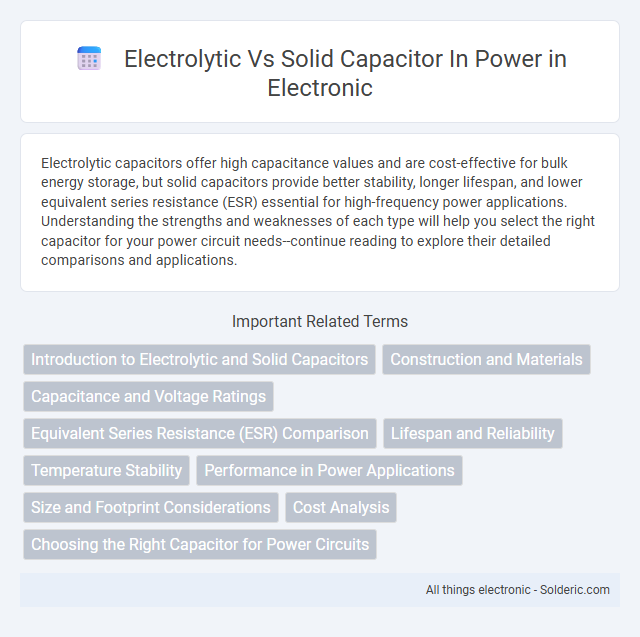Electrolytic capacitors offer high capacitance values and are cost-effective for bulk energy storage, but solid capacitors provide better stability, longer lifespan, and lower equivalent series resistance (ESR) essential for high-frequency power applications. Understanding the strengths and weaknesses of each type will help you select the right capacitor for your power circuit needs--continue reading to explore their detailed comparisons and applications.
Comparison Table
| Feature | Electrolytic Capacitor | Solid Capacitor |
|---|---|---|
| Dielectric Material | Liquid Electrolyte | Solid Polymer Electrolyte |
| Capacitance Range | 1uF to 1F | 1uF to 560uF |
| Voltage Rating | Up to 450V | Up to 35V (commonly) |
| Equivalent Series Resistance (ESR) | Higher ESR | Low ESR |
| Ripple Current Handling | Moderate | High |
| Lifetime | 2,000 to 5,000 hours (typical) | 10,000+ hours |
| Temperature Stability | Poor above 85degC | Good up to 105degC |
| Size | Larger for given capacitance and voltage | Smaller, compact |
| Cost | Lower cost | Higher cost |
| Applications in Power Electronics | Filtering, Bulk Energy Storage | High-frequency Filtering, Voltage Stabilization |
Introduction to Electrolytic and Solid Capacitors
Electrolytic capacitors feature a liquid electrolyte as one electrode, providing high capacitance values ideal for power supply filtering and energy storage in large currents. Solid capacitors use a solid conductive polymer or ceramic dielectric, offering greater stability, lower equivalent series resistance (ESR), and longer lifespan under thermal stress. Your choice between electrolytic and solid capacitors in power applications depends on the required capacitance, voltage rating, and reliability criteria.
Construction and Materials
Electrolytic capacitors consist of an aluminum or tantalum anode coated with an oxide layer acting as the dielectric, combined with a liquid or gel electrolyte as the cathode, enabling high capacitance values in compact sizes. Solid capacitors use a conductive polymer or manganese dioxide solid electrolyte, providing improved stability, lower equivalent series resistance (ESR), and enhanced reliability compared to electrolytic types. Construction differences directly impact performance parameters in power applications, with electrolytic capacitors favored for bulk energy storage and solid capacitors chosen for high frequency and long-life circuits.
Capacitance and Voltage Ratings
Electrolytic capacitors typically offer higher capacitance values ranging from 1 uF to several thousand uF, making them suitable for bulk energy storage and smoothing applications in power circuits. Their voltage ratings generally span from 6.3 V to 450 V, accommodating low to moderate voltage requirements. Solid capacitors, such as solid polymer types, provide lower capacitance values up to a few hundred microfarads but feature higher voltage ratings and improved stability, often exceeding 100 V, ideal for high-frequency and high-reliability power applications.
Equivalent Series Resistance (ESR) Comparison
Electrolytic capacitors typically exhibit higher Equivalent Series Resistance (ESR) compared to solid capacitors, leading to increased power losses and heat generation in high-frequency power applications. Solid capacitors feature lower ESR values, enhancing efficiency and stability in power circuits by reducing energy dissipation during rapid charge and discharge cycles. Your choice of capacitor impacts overall power quality and thermal management, with solid capacitors preferred for applications demanding high performance and reliability.
Lifespan and Reliability
Electrolytic capacitors typically have a shorter lifespan of around 1,000 to 5,000 hours under high temperature and voltage stress due to the liquid electrolyte's gradual evaporation and degradation. Solid capacitors, especially those using conductive polymer or ceramic materials, offer significantly improved reliability and lifespan, often exceeding 10,000 hours, thanks to their stable solid electrolyte and better thermal endurance. In power applications, the enhanced durability and lower ESR (Equivalent Series Resistance) of solid capacitors make them a preferred choice for maintaining long-term performance and reducing maintenance costs.
Temperature Stability
Electrolytic capacitors exhibit significant capacitance variation and reduced lifespan at high temperatures, typically rated up to 85degC or 105degC, making them less stable in power applications with thermal stress. Solid capacitors, such as polymer types, offer superior temperature stability, functioning reliably at temperatures up to 125degC or higher while maintaining consistent capacitance and lower Equivalent Series Resistance (ESR). This improved thermal performance enhances longevity and efficiency in power circuits, especially in environments with fluctuating or elevated temperatures.
Performance in Power Applications
Electrolytic capacitors offer high capacitance and energy density, making them suitable for bulk energy storage and smoothing in power supply circuits, but their equivalent series resistance (ESR) can limit efficiency and frequency response. Solid capacitors, especially polymer types, provide lower ESR, better stability, and longer lifespan, enhancing performance in high-frequency and high-ripple current applications. Choosing the right capacitor for your power design ensures optimal efficiency, thermal management, and reliability under demanding operating conditions.
Size and Footprint Considerations
Electrolytic capacitors typically offer higher capacitance values with a larger size and footprint, making them suitable for bulk energy storage in power applications. Solid capacitors deliver lower ESR and longer lifespan in a more compact form factor, optimizing space-constrained designs. Designers often balance capacitance needs against available PCB real estate by choosing electrolytic capacitors for bulk filtering and solid capacitors for decoupling or high-frequency stability.
Cost Analysis
Electrolytic capacitors typically offer a lower initial cost per microfarad, making them a budget-friendly option for high-capacitance power applications. Solid capacitors, though more expensive upfront, provide superior lifespan, stability, and reliability, which can reduce overall maintenance and replacement costs in critical power systems. Your choice depends on balancing immediate expenditure against long-term operational efficiency and durability.
Choosing the Right Capacitor for Power Circuits
Electrolytic capacitors offer high capacitance values and are suitable for bulk energy storage in power circuits, but their higher equivalent series resistance (ESR) and limited lifespan can affect performance. Solid capacitors, such as polymer or ceramic types, provide lower ESR, better stability, and longer life, making them ideal for high-frequency filtering and stable power supply regulation. Selecting the right capacitor depends on power circuit requirements including ripple current handling, temperature tolerance, and longevity to ensure optimal efficiency and reliability.
Electrolytic vs Solid Capacitor in Power Infographic

 solderic.com
solderic.com